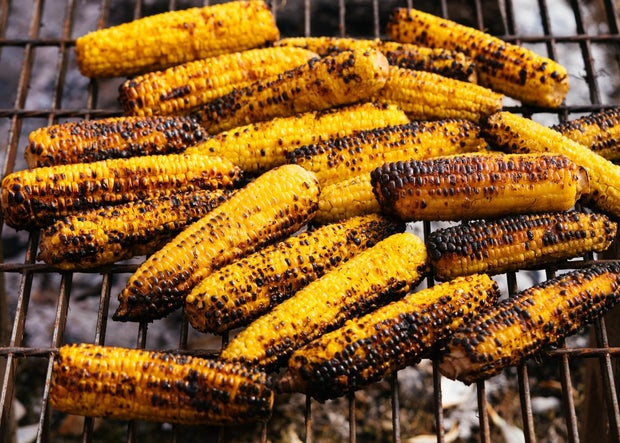CBS News
“CBS Evening News” headlines for Tuesday, Sept. 3, 2024

Watch CBS News
Be the first to know
Get browser notifications for breaking news, live events, and exclusive reporting.
CBS News
The foods chefs urge people to try during Native American Heritage Month (and beyond)

The United States is known as a great melting of people, food and culture. In major cities across the country like New York, Chicago and Los Angeles, people can find nearly any cuisine that fits their heart’s desire.
However, as Chef Sean Sherman of the Oglala Lakota Tribe has pointed out in the past, these cities have few – if any – restaurants focused on Indigenous cuisines from the more than 570 recognized American Indian tribes and Alaska Native entities. Each of these tribes has their own distinct food traditions.
KENA BETANCUR/AFP via Getty Images
Eateries like Watecha Bowl, Tocabe: An American Indian Eatery, and Owamni aim to change that by reviving or paying homage to the centuries-old techniques and flavors passed down through generations.
“We all are on the same mission of food sovereignty,” Watecha Bowl owner and entrepreneur Lawrence West told CBS News. “And introducing the world to Native American food.”
West is a member of the Cheyenne River Sioux Tribe.
“The things that I cook and the way that I prepare food is very important because it only represents a certain heritage of people,” he said.
Restaurant options around the country
West’s restaurant Watecha Bowl is a fast-food eatery in Sioux Falls, South Dakota that serves food and flavors from the Lakota Nation.
“I’ve had the privilege of feeding people from all over the world,” West said. “I’ve fed people from all 50 states.”
One of the things his restaurant is doing this year giving out an Indian taco in exchange for a toy that will be donated to local Native American kids in foster care, according to the Facebook page with 30,000 followers.
Tocabe: An American Indian Eatery is a fast-casual restaurant that serves build-your-own Native American food in Denver, Colorado. Its goal is to “rebuild the original American food system.”
Co-founder and President Ben Jacobs, told CBS News that he wants to make his cuisine accessible to everyone while offering a space for Native community members to feel at home. He is a tribal member of the Osage Nation of northeast Oklahoma.
Tacobe
He said he was inspired to open the eatery because Native food did not seem to have a place in the culinary industry in 2008 when it opened. More than 16 years later, Tocabe’s food still shares stories of community, culture and identity.
In Minneapolis, Minnesota, Chef Sean Sherman’s restaurant Owammni aims to “decolonize” the dining experience by purchasing ingredients from Indigenous food producers that would have been found in North America before European colonization.
“It’s unfortunate that this restaurant is unique. Part of the goal is, how do we normalize something that’s healthy and Indigenous? We’re showing a model that’s possible,” Sherman wrote in a recent blog post on the restaurant’s website.
What are the essential dishes to try?
According to West, wojapi is a must-have. The thick berry sauce is one of the most traditional foods of the American plains. It can be used as a dip, on frybread, meat or even as is.
Next is bison, particularly chislic, invented in South Dakota. Third is wild rice with maple syrup.
Frybread is one of the most popular Native American foods. But West said this was embraced out of necessity when the U.S. government forced assimilation with stipends during the land grab and the Trail of Tears.
Jacobs emphasizes, though, that ingredients found in local grocery stores like corn, beans, squash, tomatoes, potatoes, peppers and chillies originate “right here” in America. Those are Native foods, too. He said he hopes all Americans should understand where our food comes from and appreciate the story behind it.
The Tacobe Indigenous Marketplace offers common, or not-so-common, ingredients, but they are sourced from Native producers on tribal lands.
Tacobe
A history of food
Native American food is not mainstream for a variety of reasons.
Sherman pointed to the idea of “manifest destiny,” or the 19th-century belief that the U.S. was “destined” by God to expand across North America to spread democracy and capitalism.
West and Sherman also pointed to “forced assimilation,” or the U.S. government’s aim to make Native people adopt the customs, values and behaviors of the dominant culture. Laws like The Indian Removal Act of 1830, The Homestead Act of 1862, The Dawes Act of 1887 and others helped make this happen.
According to Britannica, The Trail of Tears refers to the forced relocation of Native people in the Southeastern U.S. during the 1830s. Tribal military records estimate that around 100,000 indigenous people were forcibly removed from their homes.
Policies like these disrupted Native food systems, leading to food insecurity and poor health outcomes, according to the Center on Budget and Policy Priorities (CBPP).
The CBPP said the U.S. has made treaties with tribes since the 1700s, promising to provide Indigenous people with rations, giving them food like lard, wheat and flour, which were often unhealthy.
According to the 2023 U.S. Census data, around 1.3% of Americans identify as American Indian or Native American.
Jacobs said after centuries of the American government deconstructing Native food systems, “we’re trying to rebuild.”
“I think we’re at a point now that we can control our food again, which means we can control our future,” he said.
CBS News
11/28: CBS Mornings Plus – CBS News

Watch CBS News
Be the first to know
Get browser notifications for breaking news, live events, and exclusive reporting.
CBS News
Dog found and reunited with owner 9 days after escaping from plane at Paris airport, forcing closure of runways

A dog whose escape from a plane caused the closure of two runways at France’s biggest airport has been reunited with its owner after nine days at large, Air France said.
Authorities closed two runways at Paris Charles de Gaulle airport on Tuesday while officials tried to capture Amalka the dog.
Since Amalka, a female, slipped out of a carrier cage on November 19 during an unloading operation, there has been an intense search for the pet, owned by an Austrian tourist who flew to France on Air France from Vienna.
“After several days of intense searches, we are delighted to confirm that Amalka has been found and returned to her owner,” Air France said in a statement to AFP.
Airport police deployed a search drone on Tuesday, requiring the closures of the runways.
They picked the off-peak early afternoon for the operation, thus avoiding any impact on scheduled flights.
After the dog escaped, several search parties were launched, including at night and in the presence of the owner, whose hotel costs at Charles de Gaulle were covered by Air France.
Posters were put up to alert airport staff.
The animal was finally found in a park in Dammartin-en-Goele, a town close to the airport, according to Le Parisien daily.
The paper posted a video of Amalka and her owner being reunited, the pet wagging her tail in delight while her owner hugged her.
“Both will be able to travel to their final destination soon,” Air France added.
Charles de Gaulle, with its four runways, vies with Amsterdam’s Schiphol for the top spot as the European Union’s busiest airport.
In September 2023, a similar incident unfolded at one of the busiest transit hubs in the U.S. when a Chihuahua mix named Maia escaped from her carrier and ran onto an active runway at Atlanta’s airport. The incident occurred while the dog was being transferred between Delta Air Lines and the airport after her owner was detained for not having the proper documents to enter the U.S. Maia was eventually found by a Good Samaritan after 22 days on the tarmac










